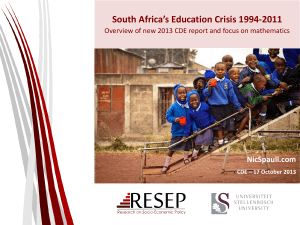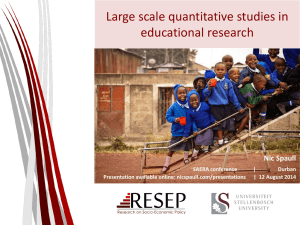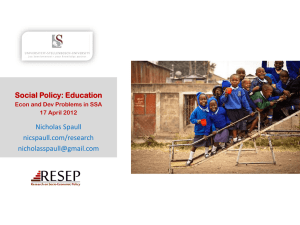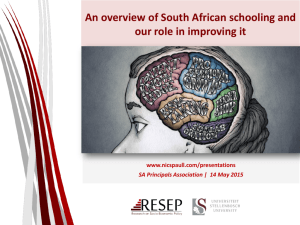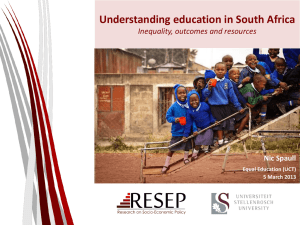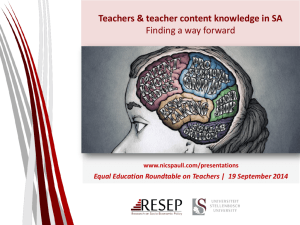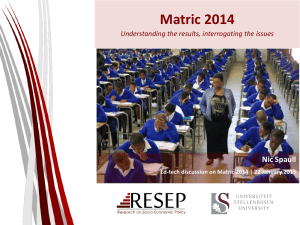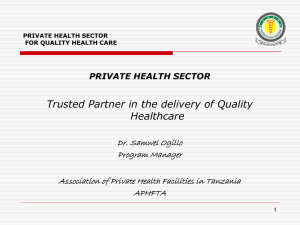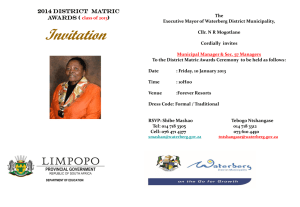Education and Social Policy - Nic Spaull
advertisement
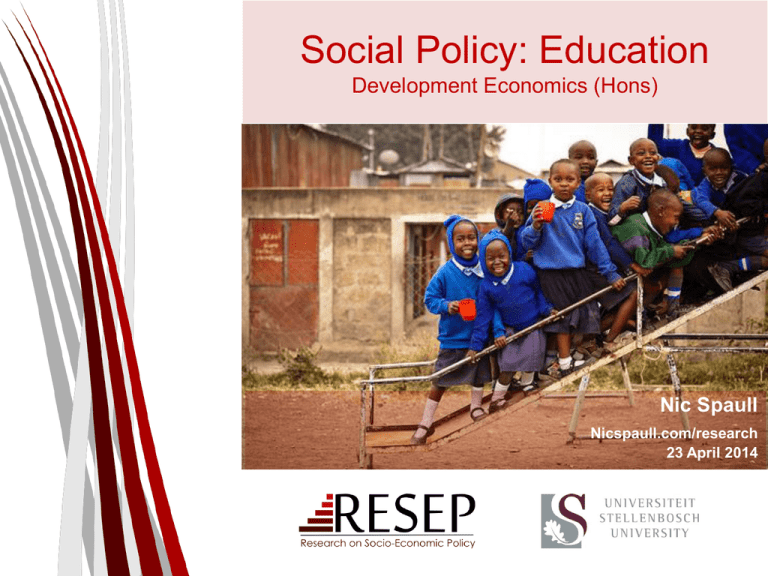
Social Policy: Education
Development Economics (Hons)
Nic Spaull
Nicspaull.com/research
23 April 2014
Social Policy & Education
Firstly, what is social policy?
“Social policy primarily refers to the guidelines, principles, legislation and
activities that affect the living conditions conducive to human welfare”
“Public policy and practice in the areas of health care, human services,
criminal justice, inequality, education, and labour”
“Social Policy is defined as actions that affect the well-being of members
of a society through shaping the distribution of and access to goods and
resources in that society”
Social Policy & Education
• Secondly, how does education fit into it?
– Most areas of social policy influence education (in some way), and are
influenced by education (in some way)
– Bidirectional causality
– Multiple benefits of education…
Ed
Benefits of education
H
S
E
c
$
Society
Improved human rights
Empowerment of women
Reduced societal violence
Promotion of a national (as
opposed to regional or ethnic)
identity
Increased social cohesion
Health
Lower fertility
Improved child health
Preventative health care
Demographic transition
Economy
Improvements in productivity
Economic growth
Reduction of inter-generational
cycles of poverty
Reductions in inequality
Specific references: lower fertility (Glewwe, 2002), improved child health (Currie, 2009), reduced societal violence (Salmi, 2006), promotion of a national - as
opposed to a regional or ethnic - identity (Glewwe, 2002), improved human rights (Salmi, 2006), increased social cohesion (Heyneman, 2003), Economic growth
– see any decent Macro textbook, specifically for cognitive skills see (Hanushek & Woessman 2008)
Social Policy & Education
• Secondly, how does education fit into it?
– Education itself affects society & the individual in real and meaningful
ways:
• Transforms individual capabilities, values, aspirations and desires (see Sen)
• Allows individuals to think, feel and act in different ways
• Enables new ways of organizing and supporting social action that depend on
numeracy and literacy, technologies of communication and abstract thinking skills
(Lewin, 2007). Democratic participation, knowledge creation etc.
• Education increases peoples ability to add value (productivity)
• “Modernising societies use educational access and attainment as a primary
mechanism to sort and select subsequent generations into different social and
economic roles” (Lewin, 2007: 3) Distribution of income
– NB NB Education is different to the other forms of social policy in that
it has the potential to change the GENERATIVE MECHANISMS of the
income distribution, not simply re-allocating it once earned (as with
grants)
Theory: Human Capital
Education increases peoples ability to add value (productivity) HCM
+
Man
=
Skills & health
Incr MP of L
Incr profits
Incr wage
“The failure to treat human resources explicitly as a form of capital, as a produced means of
production, as the product of investment, has fostered the retention of the classical notion of
labour as a capacity to do manual work requiring little knowledge and skill, a capacity with
which, according to this notion, labourers are endowed about equally. This notion of labour
was wrong in the classical period and it is patently wrong now. Counting individuals who can
and want to work and treating such a count as a measure of the quantity of an economic
factor is no more meaningful than it would be to count the number of all manner of
machines to determine their economic importance” (Schultz, 1961, p. 3).
Theory: Sorting & signalling
• Education does not improve productivity or produce HC,
instead acts as a signal of innate productivity/IQ/motivation.
– Those with higher productivity/IQ/motivation will find it easier to get
higher levels of education than those with lower P/IQ/M
• Do we care if it is HCM or Signalling?
– Yes! Implications for public investment.
Elusive equity
• Given the strong links between education and income, educational
inequality is a fundamental determinant of income inequality.
• Clear need to understand SA educational inequality if we are to
understand SA income inequality.
• High inequality + unemployment 2 of the most severe problems facing SA
– Educational quality is intimately intertwined with both of these.
• “Education shall be free, compulsory, universal and equal for all children”
(Freedom Charter)
• Fiske and Ladd’s (2004) notions of:
1. Equal treatment
2. Equal educational opportunity
3. Educational adequacy
Not all schools are born equal
?
Pretoria Boys High School
SA public schools?
9
Education and
inequality?
Quality of
education
Duration
of
education
Type of
education
SA is the most
unequal
country in the
world
Between 78%
and 85% of
total inequality
is explained by
wage
inequality
Wages
• IQ
• Motivation
• Social
networks
• Discrimination
11
Leibbrandt et al 2010
Type
Labour Market
High productivity jobs
and incomes (17%)
•
•
•
•
•
•
•
17%
•
Type of institution
(FET or University)
Quality of institution
Type of qualification
(diploma, degree etc.)
Field of study
(Engineering, Arts etc.)
High
quality
primary
school
Some motivated, lucky or
talented students make the
transition
Vocational training
Affirmative action
Low productivity jobs &
incomes
•
•
Often manual or low skill
jobs
Limited or low quality
education
Minimum wage can exceed
productivity
-
SemiSkilled
(31%)
Quality
•
Mainly professional,
managerial & skilled jobs
Requires graduates, good
quality matric or good
vocational skills
Historically mainly white
High
quality
secondary
school
High SES
background
+ECD
Minority
(20%)
Big demand for good
schools despite fees
Some
scholarships/bursaries
Unequal
society
Majority
(80%)
Low quality
secondary
school
Low SES
background
Unskilled
(19%)
Unemployed
(Broad - 33%)
Low quality
primary
school
Attainment
•
University/
FET
12
cf. Servaas van der Berg – QLFS 2011
.005
Kernel Density of Literacy Score by Race (KZN)
.006
.004
Density
.003
.002
.002
0
20
40
60
Literacy score (%)
Black
Indian
80
0
0
0
.001
.005
.01
.015
kdensity reading test score
.004
.02
U-ANA 2011
100
0
0
200
White
Asian
400
reading test score
600
200
800
Poorest 25%
Second wealthiest 25%
English/Afrikaans schools
African language schools
400
600
Learner Reading Score
800
1000
Second poorest 25%
Wealthiest 25%
.025
PIRLS / TIMSS / SACMEQ / NSES / ANA / Matric… by Wealth / Language / Location / Dept…
Kernel Density of School Literacy by Quintile
.01
.02
Density
.015
.01
0
0
0
Density
.03
.02
.04
U-ANA 2011
.005
Density
.008
Bimodality – indisputable fact
0
20
40
60
Numeracy score 2008
Ex-DET/Homelands schools
80
Historically white schools
100
20
40
60
Average school literacy score
Quintile 1
Quintile 3
Quintile 5
80
100
Quintile 2
Quintile 4
13
Student performance 2003-2011
TIMSS (2003) PIRLS (2006) SACMEQ (2007) ANA (2011) TIMSS (2011) prePIRLS (2011)
TIMSS 2003 (Gr8 Maths & Science)
PIRLS 2006 (Gr 4/5 – Reading)
•
Out of 50 participating countries (including 6
African
countries)
SA came
last SA came
•SACMEQ
Out of III
45
participating
countries
last
2007
(Gr6
– Reading
& Maths)
••
Only
10%
reached
low
international
benchmark
87%
of gr410/15
and 78%
of Gr 5 learners
deemed
to be
•ANA
SA
came
8/15
for2003
maths
2011
(Grrisk
1-6offor
Reading
&and
Maths)
•
No
improvement
from
TIMSS
1999-TIMSS
“at
serious
notreading
learning
to read”
600
560
520
480
440
400
360
320
280
240
200
Middle-income countries
Quintile 1
Quintile 2
Quintile 3
Quintile 4
Quintile 5
Independent
and this is at the improved level of performance
Russian Federation
Lithuania
Kazakhstan
Ukraine
Armenia
Romania
Turkey
Lebanon
Malaysia
Georgia
Thailand
Macedonia, Rep. of
Tunisia
Chile
Iran, Islamic Rep. of
Jordan
Palestinian Nat'l Auth.
Botswana (Gr9)
Indonesia
Syrian Arab Republic
Morocco
South Africa (Gr9)
Honduras (Gr9)
Ghana
TIMSS 2011 Mathematics score
behind countries such as Swaziland, Kenya and
•TIMSS
Mean
35%
2011literacy
(Gr9 – score
Mathsgr3:
& Science)
Tanzania
•
SA has joint
lowest performance
42 countries
•prePIRLS2011
Mean
numeracy
score gr3:of28%
(Gr 4 Reading)
Improvement by 1.5 grade levels (2003-2011)
••• Mean
literacy
score
gr6:completely
28%
29%
SA Gr4
learners
•
76% ofofgrade
nine students
in 2011 still had not
• illiterate
numeracy
score
gr6:
30%
acquired
a (cannot
basic understanding
about
whole
decode
text
in
any
• Mean
NSES
2007/8/9
numbers, decimals, operations or basic graphs,
langauge)
South Africa (Gr9)
•
Systemic Evaluations 2007
•
Matric exams
14
NSES question 42
NSES followed about 15000 students (266 schools) and tested them in Grade 3 (2007),
Grade 4 (2008) and Grade 5 (2009).
Grade 3 maths curriculum:
“Can perform calculations
using appropriate symbols to
solve problems involving:
division of at least 2-digit by
1-digit numbers”
100%
Even at the end of Grade 5
most (55%+) quintile 1-4
students cannot answer
this simple Grade-3-level
problem.
90%
35%
80%
70%
59%
57%
57%
55%
60%
50%
40%
13%
14%
14%
15%
20%
13%
10%
12%
12%
10%
16%
19%
17%
17%
Q1
Q2
Q3
Q4
30%
13%
Still wrong in Gr5
14%
Correct in Gr5
Correct in Gr4
Correct in Gr3
39%
0%
“The powerful notions of ratio, rate
and proportion are built upon the
simpler concepts of whole number,
multiplication and division, fraction
and rational number, and are
themselves the precursors to the
development of yet more complex
concepts such as triangle similarity,
trigonometry, gradient and calculus”
(Taylor & Reddi, 2013: 194)
Q5
Question 42
(Spaull & Viljoen, forthcoming)
15
Of 100 students that started school in 2002
16%
Do not reach matric
Fail matric 2013
49%
Pass matric 2013
24%
Pass with university
endorsement 2013
11%
• 550,000 students drop out before matric
• 99% do not get a non-matric qualification (Gustafsson, 2011: p11)
• What happens to them? 50% youth unemployment.
16
Insurmountable learning deficits: 0.3 SD
South African Learning Trajectories by National Socioeconomic Quintiles
Based on NSES (2007/8/9) for grades 3, 4 and 5, SACMEQ (2007) for grade 6 and TIMSS (2011) for grade 9)
13
12
11
10
Effective grade
9
8
Quintile 1
7
Quintile 2
6
Quintile 3
5
Quintile 4
4
Quintile 5
Q1-4 Trajectory
3
Q5 Trajectory
2
1
0
Gr3
Gr4
(NSES 2007/8/9)
Gr5
Gr6
(SACMEQ
2007)
Gr7
Gr8
Projections
Gr9
Gr10
(TIMSS 2011)
Gr11
Gr12
Projections
Actual grade (and data source)
Spaull & Viljoen, 2014 (SAHRC Report)
17
The impact of SES on reading/maths
Indication of wasted human
capital potential (see
Schleicher, 2009)
600
550
SEY MAU MAU
550
500
SWA
KEN
ZAN
BOT
KEN
SACMEQ
TAN
ZIM
SEY
NAM
SWA
UGA MOZ
LES
450500
In South Africa socioeconomic
status largely determines
outcomes (with a very small
number of exceptions – see
newspapers for examples)
TAN
SOU
ZIM BOT
SACMEQ
SOU
ZAN
MOZ
UGA
LES
ZAM
MAL
400 450
•
Average SACMEQ reading score
•
Almost 40% of SA student
reading achievement can be
explained by socioeconomic
status (31 assets, books,
parental education) alone.
Average SACMEQ mathematics score
•
650
600
(SACMEQ III – 2007 Gr 6)
NAM
MAL
ZAM
0
0
1010
20 20
30
30
40
Percentage of variance in performance explained by household socioeconomic status (r-squared X 100)
Percentage of variance in performance explained by household socioeconomic status (r-squared X 100)
Spaull, 2013
Intergenerational poverty
Ideal world (AKA Finland )
1.Means blind
– Ideally, an education system should be
‘means blind’ in that it offers equal
educational opportunities to all
students.
2.Meritocratic
– Ideally, an individuals success at
school (and later in the labour-market)
should depend on ability and effort
not class or wealth.
•In SA, neither of these criteria are
met. Low quality education is a
poverty trap.
Low
quality
education
Low
social
mobility
Hereditary
poverty
SA educational inequality
Questions
• If not the quality of education, what is the
driving force behind income inequality?
– Demand-side factors > supply-side?!
• Why is it so difficult to change educational
outcomes? (20 years since 1994!)
• What are the key interactions between
education and health/social-security?
Conclusion
Persistent patterns of poverty and
privilege
Low
quality
education
Low
social
mobility
Hereditary
poverty
• Educational inequality is at the heart of income inequality and
poverty
– Increasing wages for the majority of Black labour market entrants is
necessary to lower income inequality
– This is not possible without improving the quality of education they
receive
• SA has 2 education systems not one
– Implications for reporting (means are misleading)
– Implications for policy
• SA cannot convert material advantage into cognitive skills
– Inefficient use of resources
Conclusions & Implications
Low
quality
education
Low
social
mobility
Hereditary
poverty
Persistent patterns of poverty
and privilege
23
Suggestions
Acknowledge the extent of the problem
• Low quality education is one of the three largest crises facing our country (along
with HIV/AIDS and unemployment). Need the political will and public support for
widespread reform.
Experiment to figure out what works
• More of the same hasn’t worked Need to try new things and rigorously evaluate
them to see what works.
– Workbooks & ANA’s are a positive sign (Workbook delivery?)
– Failed programmes provide useful information when acknowledged & disseminated.
• Leave existing salaries the same but pay good teachers more – why not?
Increase accountability, information & transparency
• Where is the money going?
• Deal ruthlessly with corruption – this is a social crime.
• For at least one grade (Gr6?) get ANA externally validated by an independent body
like Umalusi and get this information to parents need to empower parents with
information in an accessible format
References
•
•
•
•
•
•
•
•
•
•
•
Becker, G. (1962). Investment in Human Capital: A Theoretical Analysis. The Journal of Political Economy, 70(5), 9-49.
Currie, J. (2009). Healthy, Wealthy, and Wise: Socioeconomic Status, Poor Health in Childhood, and Human Capital
Development. Journal of Economic Literature, 47(1), 87-122.
Donalson, A. (1992). Content, Quality and Flexibility: The Economics of Education System Change. Spotlight 5/92.
Johannesburg: South African Institute of Race Relations.
Fleisch, B. (2008). Primary Education in Crisis: Why South African schoolchildren underachieve in reading and mathematics.
Cape Town. : Juta & Co.
Hanushek, E. & Woessmann, L. (2008). The Role of Cognitive Skills in Economic Development. Stanford Institute for Economic
Policy Research Working Paper No. 07-34.
Hoadley, U. (2010). What do we know about teaching and learning in primary schools in South Africa? Stellenbosch:
Appendix B to Van der Berg, S; Meyer, H; Reeves, C; van Wyk, C; Hoadley, U; Bot, M; & Armstrong, P 2010. 'Grade 3
Improvement Project: Main report and Recommendations" for Western Cape Education Department.
Schultz, T. (1961). Investment in Human Capital. The American Economic Review , 51 (1), 1-17.
Shepherd, D. (2011). Constraints to School Effectiveness: What prevents poor schools from delivering results? Stellenbosch
Economic Working Papers 05/11.
Spaull, N. (2011). Primary School Performance in Botswana, Mozambique, Namibia and South Africa: A Comparative Analysis
of SACMEQ III. SACMEQ Working Papers , 1-74.
Taylor, S. (2011). Uncovering Indicators of Effective School Management in South Africa using the National School
Effectiveness Study. Stellenbosch Economic Working Papers .
Van der Berg, S. (2007). Apartheid's Enduring Legacy: Inequalities in Education. Journal of African Economies, 16(5), 849-880.
Thank you
www.nicspaull.com/research
nicholasspaull@gmail.com
@NicSpaull
ECD
Gr 1 - Gr 2 - Gr 3 – Gr 4 – Gr 5 – Gr 6 – Gr 7 – Gr 8 – Gr 9 - Gr 10 – Gr 11 – Gr 12
Foundation Phase
Foundation Phase
Intermediate Phase
Intermediate Phase
Senior Phase
Senior Phase
FET Phase
FET Phase
Mother-tongue instruction
De facto / De jure ?
Primary school
High school
Main drop-out zone
27
Theory – education in SA
SES at birth
•Type of tertiary education
(quality) - institution and
field of study
•Demand and supply
•Individual motivation
Cognitive
ability in
early
childhood
Labour
market
performance
•Parental IQ (assortative
mating)
•Maternal health
•Nutrition
•Early cognitive
stimulation: preschool
(quantity & quality), home
environment
South
Africa
•Cost of tertiary education
(explicit & implicit costs)
•Parental & personal
aspirations and
perceptions
•Society/culture
Ultimate
educational
attainment
and quality
Educational
performance
in early
school years
•Average school SES
•Language of learning &
teaching (LOLT)
•Teacher quality
•Peer effects
•Subject choice
Educational
achievement
in matric
(See Taylor, 2010)
Overview of what we know about inequality
and underperformance in South Africa
Gr 1 - Gr 2 - Gr 3 – Gr 4 – Gr 5 – Gr 6 – Gr 7 – Gr 8 – Gr 9 - Gr 10 – Gr 11 – Gr 12
Foundation Phase
Intermediate Phase
Senior Phase
FET Phase
National School Effectiveness
Study (NSES)
•Grade 3 (2007); Grade 4 (2008); Grade 5
(2009) – Panel 268 schools
• [All provinces except Gauteng]
___________________________________
_
Underperformance
•Language: In 44% of Gr4 and 32% of Gr5 classes
there was no paragraph writing done over the year
(from best learner).
•Mathematics: 88% of Gr5 maths teachers covered
no more than 35 of the 89 topics (40%) in the gr5
maths curriculum
Inequality
•Frequency of paragraph writing (half a page or
less) EC/KZN=1.7; WC=5.8 /year
•Grade 3 students in historically white schools
perform much better on the same test than grade 5
students from historically black schools
Taylor, 2011
30
Gr 1 - Gr 2 - Gr 3 – Gr 4 – Gr 5 – Gr 6 – Gr 7 – Gr 8 – Gr 9 - Gr 10 – Gr 11 – Gr 12
Foundation Phase
Intermediate Phase
Senior Phase
FET Phase
•29% of gr4 students did not reach the low
international benchmark – they could not read
•SA performs similarly to Botswana, but 3 years
learning behind average Columbian Gr4
.003
0
Underperformance
.002
•Grade 4 – all 11 languages
• 433 schools, 19259 students
___________________________________
_
.001
kdensity reading test score
prePIRLS 2011
.004
.005
PIRLS 2006 – see Shepherd (2011)
0
200
•Linguistic inequalities: Large differences by home
language – Xitsonga, Tshivenda and Sepedi
students particularly disadvantaged
•PIRLS (2006) showed LARGE differences between
African language schools and Eng/Afr schools
•*Data now available for download
800
English/Afrikaans schools
prePIRLS 2011 Benchmark Performance by Test Language
47
53
53
Tshivenda
47
24
siSwati
0
0
76
0.25
Setswana
34
66
0.1
Sesotho
36
64
0.1
57
Sepedi
43
29
isiZulu
0.8
0.4
62
31
isiNdebele
0
71
38
isiXhosa
•Howie et al (2011)
600
African language schools
Xitsonga
Inequality
400
reading test score
69
0.2
English
10
90
19
Afrikaans
12
88
15
South Africa
29
Did not reach
High International Benchmark
71
6
Low International benchmark
Advanced International benchmark
31
Intemediate International Benchmark
Gr 1 - Gr 2 - Gr 3 – Gr 4 – Gr 5 – Gr 6 – Gr 7 – Gr 8 – Gr 9 - Gr 10 – Gr 11 – Gr 12
Intermediate Phase
Senior Phase
FET Phase
0
.002
•Grade 6 – Numeracy and literacy
•392 schools, 9071 students
___________________________________
_
Density
SACMEQ 2007
.004
.006
.008
Foundation Phase
0
Underperformance
Inequality
•Large differences between quintiles (see table
later)
•Large inequalities in maths teacher content
knowledge
400
600
Learner Reading Score
Poorest 25%
Second wealthiest 25%
Mean
Lower bound confidence interval (95%)
800
1000
Second poorest 25%
Wealthiest 25%
Upper bound confidence interval (95%)
950
Maths-teacher mathematics score
•27% of students functionally illiterate
•SA performs worse than many low-income African
countries (Tanzania, Kenya, Swaziland, Zimbabwe)
•No improvement between SACMEQ II (2000) and
SACMEQ III (2007)
•Although majority (98%) of students are enrolled,
sometimes almost no learning
200
900
KEN
850
ZIM
UGA
TAN
SWASEY
BOT
NAM
MALSOU
LESZAMMOZ
800
750
700
650
600
Q5-SOU
Q4-SOU
Q3-SOU
Q2-SOU
Q1-SOU
ZAN
32
Gr 6 Teacher Content Knowledge - see McKay & Spaull (2013)
SACMEQ III (Spaull & Taylor, 2012)
100%
90%
80%
70%
60%
50%
40%
30%
20%
10%
0%
2
6
44
9
13
18
25
26
52
53
61
39
58
45
30
14
12
18
11
11
27
17
2
8
34
50
54
8
5
1
11
62
50
31
19
37
13
7
3
15
Literacy
Enrolled and acquired higher order reading skills (Levels 6-8) by grade 6
Enrolled and acquired basic reading skills (Levels 3-5) by grade 6
Enrolled but functionally illiterate (Levels 1-2) by grade 6
Never enrolled or dropped out prior to Grade 6
100%
90%
80%
70%
60%
50%
40%
30%
20%
10%
0%
1
0
29
34
59
3
2
2
46
50
53
50
10
10
5
58
64
77
11
15
8
11
13
71
51
44
12
8
14
7
37
11
34
11
39
24
2
8
Numeracy
Enrolled and acquired higher order numeracy skills (Levels 6-8) by grade 6
Enrolled and acquired basic numeracy skills (Levels 3-5) by grade 6
Enrolled but functionally innumerate (Levels 1-2) by grade 6
Never enrolled or dropped out prior to grade 6
11
5
Gr 1 - Gr 2 - Gr 3 – Gr 4 – Gr 5 – Gr 6 – Gr 7 – Gr 8 – Gr 9 - Gr 10 – Gr 11 – Gr 12
Intermediate Phase
•Avg Q1/Q2 Gr9 student is 3yrs (4yrs) worth of
learning behind the average Q5 student in maths
(science)
•Avg Gr 9 student in ECA is 2yrs worth of learning
behind avg Gr9 student in GAU
*Data now available for download
443
433
352
276
275
264
285
1995
1999
2002
2002
Grade 8
2011
Grade 9
332
2011
260
243
244
268
1995
1999
2002
2002
TIMSS
middleincome
country
Gr8
mean
TIMSS Mathematics
600
560
520
480
440
400
360
320
280
240
200
Grade 8
2011
Grade 9
2011
TIMSS
middleincome
country
Gr8
mean
TIMSS Science
Middle-income countries
Quintile 1
Quintile 2
Quintile 3
Quintile 4
Quintile 5
Independent
Underperformance
•76% of Gr9 students had not acquired a
basic understanding about whole numbers,
decimals, operations or basic graphs (i.e.
had not reached low int. benchmark)
•Avg. Gr 9 SA student is 2yrs (2.8yrs) behind
the average Gr8 student from a middle
income country in maths (science)
•Contrary to popular belief, even South
Africa’s “top” schools do not perform well
by international standards…
Inequality
480
440
400
360
320
280
240
200
160
120
80
40
0
FET Phase
Russian Federation
Lithuania
Ukraine
Kazakhstan
Turkey
Iran, Islamic Rep. of
Romania
Chile
Thailand
Jordan
Tunisia
Armenia
Malaysia
Syrian Arab Republic
Georgia
Palestinian Nat'l Auth.
Macedonia, Rep. of
Indonesia
Lebanon
Botswana (Gr 9)
Morocco
Honduras (gr 9)
South Africa (Gr 9)
Ghana
•Grade 9 – Maths and science
•285 schools, 11969 students
___________________________________
_
TIMSS score
TIMSS 2011
Senior Phase
TIMSS 2011 Science score
Foundation Phase
34
South Africa (Gr9)
Performance of quintile five schools in TIMSS 2003 Maths
.004
0
.002
Density
.006
.008
– see Taylor MST (2011)
0
200
400
Grade 8 mathematics score
South Africa Quintile 5
Chile Quintile 5
Singapore Quintile 5
600
800
Chile
Singapore
Even Q5 schools in SA perform at a comparatively low level
Gr 1 - Gr 2 - Gr 3 – Gr 4 – Gr 5 – Gr 6 – Gr 7 – Gr 8 – Gr 9 - Gr 10 – Gr 11 – Gr 12
Intermediate Phase
Senior Phase
Matric
Inequality
•Subject combinations differ between rich and poor
– differential access to higher education
•Maths / Maths-lit case in point
•Are more students taking maths literacy because
THEY cannot do pure-maths, or because their
TEACHERS cannot teach pure-maths?
Number of students
•Of 100 students that enroll in grade 1
approximately 50 will make it to matric, 40 will
pass and 12 will qualify for university
Grade 10 (2 years earlier)
Grade 12
Those who pass matric
Pass matric with maths
Proportion of matrics taking mathematics
•Grade 12 – Various
•Roughly half the cohort
___________________________________
_
Underperformance
FET Phase
1200000
60%
1000000
50%
800000
40%
600000
30%
400000
20%
200000
10%
0
0%
Matric 2008 (Gr Matric 2009 (Gr Matric 2010 (Gr Matric 2011 (Gr
10 2006)
10 2007)
10 2008)
10 2009)
36
Proportion of matrics (%)
Foundation Phase
See Taylor (2012)
Matric
1200000
•More students making it to grade 10 but
not more making it to matric
• Partially due to less repetition at lower grades
•LARGE differences in the ability of
provinces to “convert” grade 1 enrolments
into matric passes
•Why are more students taking maths
literacy?
1000000
800000
600000
400000
200000
0
grade 10
Grade 12
The ratio of grade 2 enrolments ten years prior to matric to matric passes by province
See Taylor (2012)
Matric pass rate
Media sees only this
What are the root
causes of low and
unequal
achievement?
MATRI
C
Pre-MATRIC
HUGE learning deficits…
38
• Social policy implications?
Distribution of functional illiteracy and innumeracy by country and province
50
SACMEQ III
LMP
40
TET
ECA
30
NIA
SOF
S
CAB
KZN
MPU
MAN
NAM
FST
NWP
NCA
20
M
OSHOMU
ZAM
HAR
OHA
SOU
10
GTNWES SOC
CES
B
CEN
N
OMA
KUN
KAR
KHO
GAZ
INH
SHN
NOR
WCA
CAP
KAV
MAP
ERO
OTJ
CID
GAB
10
20
30
40
50
60
Proportion functionally innumerate
Botswana & provinces
Mozambique & provinces
Namibia & provinces
South Africa & provinces
70
Questions,
conclusions &
recommendations
Conclusions
• Speaking of a single education system in SA
is a misnomer – the average South African
student does not exist in any meaningful
sense.
Bimodality is a fact.
Low
quality
education
Low
social
mobility
Hereditary
poverty
• South Africa is not able to convert material
advantage into cognitive skills
Highly inefficient
• While the survey was conducted in 2007,
and things may have changed, the outcomes
certainly haven’t (see ANA’s, 2011; and (?)
PIRLS/TIMSS 2011)
More of the same?
Serious blight on the national
conscience
Persistent patterns of poverty
and privilege
When faced with an exceedingly low and unequal quality of
education do we….
A) Increase accountability {US model}
• Create a fool-proof highly specified, sequenced curriculum (CAPS/workbooks)
• Measure learning better and more frequently (ANA)
• Increase choice/information in a variety of ways
B) Improve the quality of teachers {Finnish model}
• Attract better candidates into teaching degrees draw candidates from the
top (rather than the bottom) of the matric distribution
• Increase the competence of existing teachers (Capacitation)
• Long term endeavor which requires sustained, committed, strategic,
thoughtful leadership (something we don’t have)
C) All of the above {Utopian model}
•Perhaps A while we set out on the costly and difficult journey of B??
43
Suggestions
Get the basics right
–
–
–
–
–
–
–
–
–
Teachers need to be in school teaching
Every child (teacher) needs access to adequate learning (teaching) materials
Every school should meet basic sanitation and health requirements
Every child should receive one year of adequate quality preschool education
No child should be hungry at school (for social & cognitive reasons)
Continuous diagnostic testing to figure out what children actually know
Make sure that the curriculum is tailored to the educational needs of the majority of
students, not the top 15%
Every student MUST master the basics of foundational numeracy and literacy – these
are the building blocks of further education – weak foundations = recipe for disaster
SA is a middle income country which spends 20% (!) of all government
expenditure on education – this is not rocket science.
[ANA’s and workbooks are a very good sign – (but) need consistency and
time]
